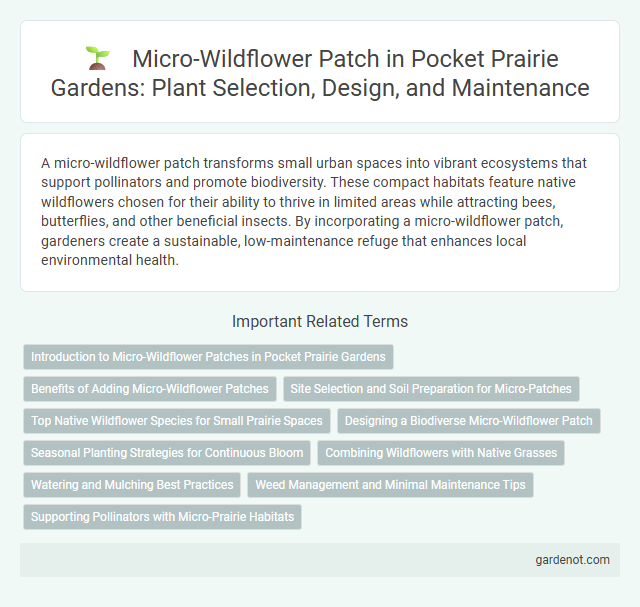A micro-wildflower patch transforms small urban spaces into vibrant ecosystems that support pollinators and promote biodiversity. These compact habitats feature native wildflowers chosen for their ability to thrive in limited areas while attracting bees, butterflies, and other beneficial insects. By incorporating a micro-wildflower patch, gardeners create a sustainable, low-maintenance refuge that enhances local environmental health.
Introduction to Micro-Wildflower Patches in Pocket Prairie Gardens
Micro-wildflower patches in pocket prairie gardens enhance biodiversity by supporting native pollinators and beneficial insects. These small-scale habitats use a mix of native wildflower species, promoting ecological balance and improving soil health. Integrating micro-wildflower patches contributes to urban greening, offering vibrant seasonal blooms that sustain local wildlife.
Benefits of Adding Micro-Wildflower Patches
Micro-wildflower patches enhance biodiversity by providing vital habitats for pollinators such as bees, butterflies, and beneficial insects, supporting local ecosystems and improving plant pollination rates. These patches contribute to soil health by promoting microbial activity and reducing erosion through root structures, while also requiring minimal maintenance compared to traditional lawns. Integrating micro-wildflower patches in pocket prairies increases aesthetic appeal, fosters environmental education, and supports sustainable urban landscaping practices.
Site Selection and Soil Preparation for Micro-Patches
Selecting a well-drained location with partial to full sunlight is essential for establishing a successful micro-wildflower patch within a pocket prairie. Soil preparation involves loosening the top 6-8 inches and incorporating organic matter such as compost to enhance nutrient availability and drainage. Testing soil pH and adjusting to a slightly acidic to neutral range (6.0-7.0) optimizes conditions for native wildflower seed germination and growth.
Top Native Wildflower Species for Small Prairie Spaces
Top native wildflower species ideal for pocket prairie micro-wildflower patches include Echinacea purpurea (Purple Coneflower), Asclepias tuberosa (Butterfly Milkweed), and Rudbeckia hirta (Black-eyed Susan), all known for high pollinator attraction. These species thrive in small prairie spaces due to their drought tolerance, compact growth, and adaptability to urban soil conditions. Incorporating Solidago spp. (Goldenrod) and Coreopsis lanceolata (Lanceleaf Coreopsis) enhances biodiversity and supports native insects in confined natural habitats.
Designing a Biodiverse Micro-Wildflower Patch
Designing a biodiverse micro-wildflower patch involves selecting native wildflower species that support pollinators, such as bees and butterflies, while ensuring varied bloom times for continuous nectar sources. Incorporating a mix of grasses and flowering plants enhances soil health and attracts beneficial insects, promoting ecological balance. Careful site preparation and minimal disturbance encourage natural seed germination and sustainable growth in the pocket prairie environment.
Seasonal Planting Strategies for Continuous Bloom
A well-designed micro-wildflower patch employs seasonal planting strategies to ensure continuous bloom from spring through fall, selecting native species with staggered flowering periods. Early bloomers like Virginia bluebells provide vibrant color in spring, while mid-season asters and late-blooming goldenrods extend nectar sources into autumn. Incorporating a diverse mix of perennials and annuals maximizes habitat value for pollinators and enhances the ecological resilience of the pocket prairie.
Combining Wildflowers with Native Grasses
A micro-wildflower patch that combines wildflowers with native grasses enhances biodiversity by providing diverse habitats for pollinators and beneficial insects. Native grasses stabilize soil, support microfauna, and improve water retention, while wildflowers offer nectar sources that attract bees, butterflies, and other pollinators. This combination promotes ecological balance and resilience within pocket prairie ecosystems.
Watering and Mulching Best Practices
Proper watering practices for a micro-wildflower patch involve maintaining consistent soil moisture without overwatering, which can lead to root rot and fungal diseases. Applying a 2-3 inch layer of organic mulch such as straw or shredded leaves helps retain soil moisture, suppress weeds, and regulate temperature fluctuations. Mulching also improves soil structure over time, promoting healthier root systems essential for thriving native wildflowers in a pocket prairie setting.
Weed Management and Minimal Maintenance Tips
Micro-wildflower patches in pocket prairies thrive with strategic weed management that includes regular hand-pulling and mulching to suppress invasive species without disturbing native growth. Minimal maintenance involves choosing native wildflowers adapted to local soil and climate, reducing the need for watering and fertilization. Employing diverse plant species enhances resilience against weeds and promotes a balanced ecosystem.
Supporting Pollinators with Micro-Prairie Habitats
Micro-wildflower patches in pocket prairies create essential micro-prairie habitats that support diverse pollinator populations, including native bees, butterflies, and hummingbirds. These patches offer abundant nectar and pollen sources, enhancing local biodiversity and ecosystem resilience. Establishing such habitats contributes to pollinator conservation and promotes sustainable urban and rural landscapes.
Micro-wildflower patch Infographic

 gardenot.com
gardenot.com